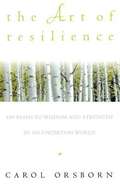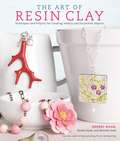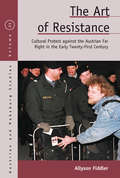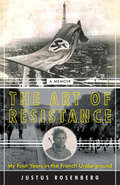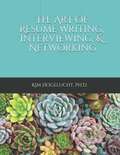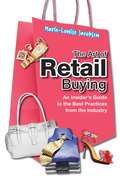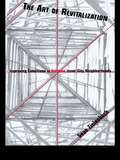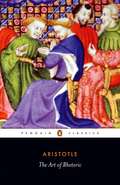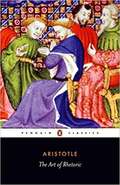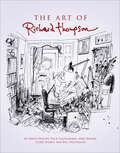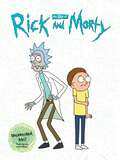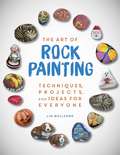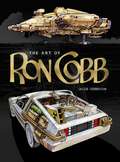- Table View
- List View
The Art of Resilience: 100 Paths to Wisdom and Strength in an Uncertain World
by Carol OrsbornCarol Orsborn, an internationally recognized businesswoman, theologian, and motivational speaker, has created an inspiring guide to one hundred different ways to find wisdom and strength in an uncertain world. Her stories, anecdotes, and practical advice - inspired by the teachings of spiritual masters from both Eastern and Western traditions - are guaranteed to help anyone learn to rebound gracefully and productively when up against forces that are beyond our control. Each practical tip, each seed of wisdom, is encased in a one- or two-page story that's touching or humorous or thought provoking. The Art of Resilience is for anyone who has ever felt overwhelmed by disappointment, illness, or loss. It is a book that offers hope and comfort and reminds us, in ways both large and small, that we must move through and beyond disappointment to find our God-given capacity for love and joy.
The Art of Resin Clay: Techniques and Projects for Creating Jewelry and Decorative Objects
by Rachel Haab Sherri Haab Michelle HaabDiscover the Creative Possibilities of Resin Clay Imagine being able to imitate the look of rare coral, create oversized but featherweight statement jewelry, or mix clay with other mediums--all without firing. The Art of Resin Clay explores the creative potential of this material, in both air-dry and two-part formulas, and guides you through everything you'll need to get started: * Information on choosing the right kind of resin clay, essential tools and techniques, and safety guidelines* Tips for mixing colors, finishing, and adding jewelry findings* 20 projects covering a variety of creative techniques * Galleries of work by influential artists and crafts designers who use this versatile materialFrom the Trade Paperback edition.
The Art of Resistance: Cultural Protest against the Austrian Far Right in the Early Twenty-First Century (Austrian and Habsburg Studies #21)
by Allyson FiddlerWell before the far-right resurgence that has most recently transformed European politics, Austria’s 1999 parliamentary elections surprised the world with the unexpected success of the Freedom Party of Austria and its charismatic leader, Jörg Haider. The party’s perceived xenophobia, isolationism, and unabashed nationalism in turn inspired a massive protest movement that expressed opposition not only through street protests but also in novels, plays, films, and music. Through careful readings of this varied cultural output, The Art of Resistance traces the aesthetic styles and strategies deployed during this time, providing critical context for understanding modern Austrian history as well as the European protest movements of today.
The Art of Resistance: My Four Years in the French Underground
by Justus Rosenberg"Thrillingly tells the story of an Eastern European Jew’s flight from the Holocaust and the years he spent fighting in the French underground.” —USA TodayAn American Library in Paris Book Award "Coups de Coeur" SelectionThe Art of Resistance is unlike any World War II memoir before it. Its author, Justus Rosenberg, has spent the past seventy years teaching the classics of literature to American college students. Hidden within him, however, was a remarkable true story of wartime courage and romance worthy of a great novel. Here is Professor Rosenberg’s elegant and gripping chronicle of his youth in Nazi-occupied Europe, when he risked everything to stand against evil.In 1937, after witnessing a violent Nazi mob in his hometown of Danzig, a majority German city on the Baltic Sea, sixteen-year-old Justus Rosenberg was sent by his Jewish parents to Paris to finish his education in safety. Three years later, the Nazis came again, as France fell to the Germans. Alone and in danger, Justus fled Paris, heading south. A chance meeting led him to Varian Fry, an American journalist in Marseille who led a clandestine network helping thousands of men and women—including many legendary artists and intellectuals, among them Hannah Arendt, Marc Chagall, Andre Breton, and Max Ernst—escape the Nazis. With his intimate understanding of French and German culture, and fluency in several languages, including English, Justus became an invaluable member of Fry’s operation as a spy and scout.After the Vichy government expelled Fry from France, Justus worked in Grenoble, recruiting young men and women for the Underground Army. For the next four years, he would be an essential component of the Resistance, relying on his wits and skills to survive several close calls with death. Once, he found himself in a Nazi internment camp, with his next stop Auschwitz—and yet Justus found an ingenious way to escape. He two years during the war gathering intelligence, surveying German installations and troop movements on the Mediterranean. Then, after the allied invasion at Normandy in 1944, Justus became a guerrilla fighter, participating in and leading commando raids to disrupt the German retreat across France.At the end of the Second World War, Justus emigrated to America, and built a new life. For the past fifty years, he has taught literature at Bard College, shaping the inner lives of generations of students. Now he adds his own story to the library of great coming-of-age memoirs: The Art of Resistance is a powerful saga of bravery and defiance, a true-life spy thriller touched throughout by a professor’s wisdom.
The Art of Resistance in Islam: The Performance of Politics among Shi'i Women in the Middle East and Beyond (Cambridge Middle East Studies #65)
by Yafa ShanneikBased on first-hand ethnographic insights into Shi'i religious groups in the Middle East and Europe , this book examines women's resistance to state as well as communal and gender power structures. It offers a new transnational approach to understanding gender agency within contemporary Islamic movements expressed through language, ritual practices, dramatic performances , posters and banners. By looking at the aesthetic performance of the political on the female body through Shi'i ritual practices – an aspect that has previously been ignored in studies on women's acts of resistance -, Yafa Shanneik shows how women play a central role in redefining sectarian and gender power relations both in the Middle East and in the European diaspora.
The Art of Resume Writing, Interviewing, & Networking: Practical and Proven Strategies for Securing Employment
by Dr Kim HogeluchtIn this 2nd Edition, Dr. Kim Hogelucht, shares best practices for not only interviewing and networking in-person but also in a remote setting. With an increasing number organizations offering remote work, as well as conducting interviews remotely, this additional content promises to be of great value to job seekers who want to stand-out not only in-person, but remotely as well. Backed with student testimonials, the strategies shared in this book are powerful, effective, and noteworthy. Topics addressed include: clear step-by-step instructions for custom resume writing, strategies for in-person and remote interviewing, and ways to expand one’s network through informational interviews and LinkedIn. The content in this book aims to provide the job seeker with the tools needed to stand-out in the job search and transform what is often viewed as a daunting process to a process they are ready and excited to tackle.
The Art of Retail Buying
by Marie-Louise JacobsenBuying for retail is a demanding and challenging job that requires a creative flair, a strong awareness of fashion trends, life trends as well as good interpersonal and team working skills. Buyers and merchandisers have to ensure that the right merchandise is being sent to the right stores, at the right time, in the right quantities. This takes a blend of forward planning and rapid response to consumer demands. In combination with the other areas of the business, success comes from maximizing profit, which is achieved through anticipating customer needs and responding rapidly to immediate issues. It involves complex data analysis, liaison with the stores operation teams and balancing store stock levels. To succeed as a professional buyer, you will need strong analytical and numerical skills, an interest and understanding of consumer demands and strong commercial awareness. You also need to have an ability to understand and prioritize issues quickly and efficiently. Progression into the Merchandising function also involves the ability to manage change. The better equipped you are in your buying function the better you will be able to adapt to these changes. The best change of all is to graduate from a good buyer to an outstanding one! To handle the complexity of data and to enable you to contribute effectively in the critical role of a buyer, you need the right skill-sets and a right mind-set. Both of which can be learned in The Art of Retail Buying. This easy to read guide is written in a concise & pictorial style with colorful images that enables you to follow step-by-step each function of a buyer. The Art of Retail Buying will inspire you, motivate you and encourage you towards merchandising excellence!
The Art of Return: The Sixties and Contemporary Culture
by James MeyerMore than any other decade, the sixties capture our collective cultural imagination. And while many Americans can immediately imagine the sound of Martin Luther King Jr. declaring “I have a dream!” or envision hippies placing flowers in gun barrels, the revolutionary sixties resonates around the world: China’s communist government inaugurated a new cultural era, African nations won independence from colonial rule, and students across Europe took to the streets, calling for an end to capitalism, imperialism, and the Vietnam War. In this innovative work, James Meyer turns to art criticism, theory, memoir, and fiction to examine the fascination with the long sixties and contemporary expressions of these cultural memories across the globe. Meyer draws on a diverse range of cultural objects that reimagine this revolutionary era stretching from the 1950s to the 1970s, including reenactments of civil rights, antiwar, and feminist marches, paintings, sculptures, photographs, novels, and films. Many of these works were created by artists and writers born during the long Sixties who were driven to understand a monumental era that they missed. These cases show us that the past becomes significant only in relation to our present, and our remembered history never perfectly replicates time past. This, Meyer argues, is precisely what makes our contemporary attachment to the past so important: it provides us a critical opportunity to examine our own relationship to history, memory, and nostalgia.
The Art of Revision: The Last Word (Art of...)
by Peter Ho DaviesThe fifteenth volume in the Art of series takes an expansive view of revision—on the page and in lifeIn The Art of Revision: The Last Word, Peter Ho Davies takes up an often discussed yet frequently misunderstood subject. He begins by addressing the invisibility of revision—even though it’s an essential part of the writing process, readers typically only see a final draft, leaving the practice shrouded in mystery. To combat this, Davies pulls examples from his novels The Welsh Girl and The Fortunes, as well as from the work of other writers, including Flannery O’Connor, Carmen Machado, and Raymond Carver, shedding light on this slippery subject.Davies also looks beyond literature to work that has been adapted or rewritten, such as books made into films, stories rewritten by another author, and the practice of retconning in comics and film. In an affecting frame story, Davies recounts the story of a violent encounter in his youth, which he then retells over the years, culminating in a final telling at the funeral of his father. In this way, the book arrives at an exhilarating mode of thinking about revision—that it is the writer who must change, as well as the writing. The result is a book that is as useful as it is moving, one that asks writers to reflect upon themselves and their writing.
The Art of Revitalization: Improving Conditions in Distressed Inner-City Neighborhoods (Contemporary Urban Affairs #Vol. 12)
by Sean ZielenbachThis book discusses the revitalization of decayed inner-city neighborhoods. It explores the role of social capital in stabilizing and turning around distressed communities, and it highlights the roles that local actors can and do play in the revitalization process.The Art of Revitalization takes two Chicago neighborhoods, Englewood and North Lawndale, as case studies. Zielenbach discusses them in the context of racial change and urban decay in Chicago since World War II. The account of the changing neighborhoods is fascinating and clear, and the strength of the author's portrayal of Chicago's transformation sets the stage for his detailed analysis.
The Art of Revolt: Snowden, Assange, Manning
by Geoffroy De Lagasnerie Erik ButlerEdward Snowden, Julian Assange, and Chelsea Manning are key figures in the struggles playing out in our democracies over internet use, state secrets, and mass surveillance in the age of terror. When not decried as traitors, they are seen as whistle-blowers whose crucial revelations are meant to denounce a problem or correct an injustice. Yet, for Geoffroy de Lagasnerie, they are much more than that. Snowden, Assange, and Manning are exemplars who have reinvented an art of revolt. Consciously or not, they have inaugurated a new form of political action and a new identity for the political subject. Anonymity as practiced by WikiLeaks and the flight and requests for asylum of Snowden and Assange break with traditional forms of democratic protest. Yet we can hardly dismiss them as acts of cowardice. Rather, as Lagasnerie suggests, such solitary choices challenge us to question classic modes of collective action, calling old conceptions of the state and citizenship into question and inviting us to reformulate the language of critical philosophy. In the process, he pays homage to the actions and lives of these three figures.
The Art of RF: Tools and Techniques for Community-Based Banking (Wiley Finance)
by Yahia Abdul-RahmanUpdated and expanded insights into Islamic banking and finance From Yahia Abdul-Rahman-the father of Riba-Free (RF) banking-comes the expanded edition of the definitive resource that offers an understanding for applying Islamic banking and financial practices. No matter what your faith or religious beliefs, the book shows how to take a modern American approach to incorporating Islamic financial principles into banking and investment techniques. The Art of RF (Riba-Free) Islamic Banking and Finance describes the emergence of a culture of Islamic banking and finance today, which is based on the real Judeo-Christian-Islamic spirit and has proven very effective when compared to 20th century models that use financial engineering and structural techniques to circumvent the Shari'aa Law. The author also reveals information about how fiat money is created, the role of the Federal Reserve, and the US banking system. Abdul-Rahman includes a wealth of real-life examples and offers an analysis of how this new brand of banking and financing yields superior results. Offers the fundamentals on Riba-Free (RF) banking Shows how to apply RF to everything from joint ventures and portfolio management to home mortgages and personal finance Reveals what it takes to incorporate Shariah Law into US financial systems Includes information on why RF banking is a socially responsible way to invest Thoroughly revised and updated, this resource offers a handbook for applying Shari'aa law to American banking and finance.
The Art of Rhetoric (Collins Classics Ser.)
by AristotleWith the emergence of democracy in the city-state of Athens in the years around 460 BC, public speaking became an essential skill for politicians in the Assemblies and Councils - and even for ordinary citizens in the courts of law. In response, the technique of rhetoric rapidly developed, bringing virtuoso performances and a host of practical manuals for the layman. While many of these were little more than collections of debaters' tricks, the Art of Rhetoric held a far deeper purpose. Here Aristotle (384-322 BC) establishes the methods of informal reasoning, provides the first aesthetic evaluation of prose style and offers detailed observations on character and the emotions. Hugely influential upon later Western culture, the Art of Rhetoric is a fascinating consideration of the force of persuasion and sophistry, and a compelling guide to the principles behind oratorical skill.
The Art Of Rhetoric
by Hugh Lawson-Tancred AristotleWith the emergence of democracy in the city-state of Athens in the years around 460 BC, public speaking became an essential skill for politicians in the Assemblies and Councils - and even for ordinary citizens in the courts of law. In response, the technique of rhetoric rapidly developed, bringing virtuoso performances and a host of practical manuals for the layman. While many of these were little more than collections of debaters' tricks, the Art of Rhetoric held a far deeper purpose. Here Aristotle establishes the methods of informal reasoning, provides the first aesthetic evaluation of prose style and offers detailed observations on character and the emotions. Hugely influential upon later Western culture, the Art of Rhetoric is a fascinating consideration of the force of persuasion and sophistry, and a compelling guide to the principles behind oratorical skill.
The Art of Richard Thompson
by David Apatoff Nick Galifianakis Mike Rhode Chris Sparks Bill WattersonA tribute to the cartoonist known as “Michelangelo with a sense of humor,” the creator of the beloved comic strip Cul de Sac (Pat Oliphant, editorial cartoonist).Richard Thompson is renowned among cartoonists as an “artist’s” cartoonist. Little known to all but those close to him is the extent of his art talent. This is the book that will enlighten the rest of us and delight us with the sheer beauty of his work.Divided into six sections, each beginning with an introductory conversation between Thompson and six well-known peers, including Bill Watterson, the book will present Thompson’s illustration work, caricatures, and his creation, Richard’s Poor Almanack. Each section is highly illustrated, many works in color, most of them large and printed one-to-a-page. The diversity of work will help cast a wider net, well beyond Cul de Sac fans.“Even working wordlessly, from his wheelchair, Thompson was, and is, the supreme comedian. And that comic timing is among the embarrassment of rich gifts on beautiful display in The Art of Richard Thompson . . . one of the most anticipated art-retrospective books of the year.” —The Washington Post“A new collection of art, interviews and commentaries . . . a more complete portrait of a multi-talented artist whose career ended far too early.” —IndieWire
The Art of Rick and Morty
by Justin RoilandFeaturing exclusive never before seen concept art with a killer Glow-in-the-Dark cover, this is the art book that Rick and Morty fans have been waiting for!The animated science-fiction adventures of Rick and Morty are irreverent, shocking, and hilarious--from the cynical and rapid-fire one liners, to the grotesquely and endearing character designs. Now, take a deep trans-dimensional dive into the creation of these many insane universes with The Art of Rick and Morty!This new book is a must-have, not only for followers of the series, but for fans of animation as well! Featuring intimate commentary from the show's creators accompanying a vast collection of process, concept, and production art, this striking volume offers a tantalizing exploration of one of the most outlandish and beloved shows on television. Don't miss your chance to see the amazing art that goes into creating this twisted and fantastic Adult Swim series!
The Art of Rick and Morty Volume 2
by Jeremy GilforThis full-color artbook showcases the third and fourth seasons of the animated science-fiction adventures of everyone's favorite alcoholic scientist and his grandson!Rick and Morty are back, baby! They never even left! Reruns, dog! Streaming! Anyway, grab your portal gun and get back to exploring the creation of this beloved TV series with its comical characters and their interdimensional counterparts, wack-a-doo aliens, and far-out locations. This full-color artbook showcases the interstellar art of the third and fourth seasons of your favorite animated sci-fi adventure.Dark Horse Books and Adult Swim offer another peek beneath the creators' curtain with The Art of Rick and Morty Volume 2. More concept art! More creator commentary! More stuff!
The Art of Rigging
by George Biddlecombe"Few, today, can realize how important was the art of rigging a ship and reeving her gear in the days just old when all aloft was wood and hemp; or how great the part it has played in the building of Empire." — Introduction.Although mastery of the art of rigging is no longer required on board today's ships, legions of serious model ship builders who wish to rig their ships correctly need to learn the art in miniature. This book is widely considered the best manual ever produced on rigging the sailing ship. It is based on the extensively revised and updated 1848 edition prepared by Captain George Biddlecombe, a Master in the Royal Navy and former merchant seaman. The book is divided into five parts:The First Part contains an alphabetical explanation of terms and phrases used in rigging. The Second Part consists of directions for the performance of operations incidental to rigging and preparing it on shore, with a table of the comparative strength of chain and rope. The Third Part contains the progressive method of rigging ships. The Fourth Part contains a description of reeving the running rigging and bending the sails in addition to the rigging of brigs, yachts, and small vessels. The Fifth Part comprises tables of the quantities and dimensions of the standing and running rigging of ships, brigs, fore-and-aft schooners, and cutters, with the species, size, and number of blocks, hearts, dead-eyes, etc.Serious modelists, naval historians, armchair skippers — any sailing buff — will want to own a copy of The Art of Rigging. Complete and wonderfully clear, it is now available in its first inexpensive paperback edition. It belongs in every maritime library.
The Art of Risk
by Richard HarrisDiving doctor on the Thai Cave Rescue (now a Netflix series) and former joint Australian of the Year explores the stories of other people who regularly risk their lives and what we can learn from their expertise. Are free-solo climbers, underwater cave explorers and big-wave surfers crazy ... or cautious? How do soldiers and fighter pilots manage risk? What can we learn from how BASE jumpers and drag racers prepare that we can take into our own lives? &‘Harry&’ Harris – Thai Cave Rescuer, joint Australian of the Year – has an unusual idea of fun: he crawls though pitch-black, confined caves, deep underground and usually underwater. To most, that&’s a nightmare. To him, it&’s recreation. He&’s prepared for all conceivable risks, he&’s completely focused. And the discipline and danger involved leave him better prepared for everyday life. In this ultimate armchair adventure, Harry takes us into the lives of other &‘risk-takers&’, to find out why they do what they do. We meet people adventuring from the highest skies to the deepest oceans – BASE jumpers, drag racers, snipers and surfers – including climber Alex Honnold (from the movie Free Solo), sailor Jessica Watson, film director and deep-sea diver James Cameron. Each gripping story is a masterclass in risk from the experts: when to go, when to say no, how to prepare and above all, how pushing ourselves a little further helps us become more courageous and resilient in all of our challenges.Heart-pounding and eye-opening, you&’ll never look at risk the same way again. &‘Richard &“Harry&” Harris peels back the mindset that shapes the line between recklessness and courage.&’ Hugh Riminton
The Art of Risk
by Kayt SukelAre risk-takers born or made? Why are some more willing to go out on a limb (so to speak) than others? How do we weigh the value of opportunities large or small that may have the potential to change the course of our lives? These are just a few of the questions that author Kayt Sukel tackles, applying the latest research in neuroscience and psychology to compelling real-world situations. Building on a portfolio of work that has appeared in such publications as Scientific American, Atlantic Monthly, The Washington Post, and more, Sukel offers an in-depth look at risk-taking and its role in the many facets of life that resonates on a personal level. Smart, progressive, and truly enlightening, The Art of Risk blends riveting case studies and hard-hitting science to explore risk-taking and how it impacts decision-making in work, play, love, and life, providing insight in understanding individual behavior and furthering personal success.From the Hardcover edition.
The Art of Rivalry: Four Friendships, Betrayals, and Breakthroughs in Modern Art
by Sebastian SmeePulitzer Prize–winning art critic Sebastian Smee tells the fascinating story of four pairs of artists—Manet and Degas, Picasso and Matisse, Pollock and de Kooning, Freud and Bacon—whose fraught, competitive friendships spurred them to new creative heights. Rivalry is at the heart of some of the most famous and fruitful relationships in history. The Art of Rivalry follows eight celebrated artists, each linked to a counterpart by friendship, admiration, envy, and ambition. All eight are household names today. But to achieve what they did, each needed the influence of a contemporary—one who was equally ambitious but possessed sharply contrasting strengths and weaknesses. Edouard Manet and Edgar Degas were close associates whose personal bond frayed after Degas painted a portrait of Manet and his wife. Henri Matisse and Pablo Picasso swapped paintings, ideas, and influences as they jostled for the support of collectors like Leo and Gertrude Stein and vied for the leadership of a new avant-garde. Jackson Pollock’s uninhibited style of “action painting” triggered a breakthrough in the work of his older rival, Willem de Kooning. After Pollock’s sudden death in a car crash, de Kooning assumed Pollock's mantle and became romantically involved with his late friend’s mistress. Lucian Freud and Francis Bacon met in the early 1950s, when Bacon was being hailed as Britain’s most exciting new painter and Freud was working in relative obscurity. Their intense but asymmetrical friendship came to a head when Freud painted a portrait of Bacon, which was later stolen. Each of these relationships culminated in an early flashpoint, a rupture in a budding intimacy that was both a betrayal and a trigger for great innovation. Writing with the same exuberant wit and psychological insight that earned him a Pulitzer Prize for art criticism, Sebastian Smee explores here the way that coming into one’s own as an artist—finding one’s voice—almost always involves willfully breaking away from some intimate’s expectations of who you are or ought to be.
The Art of Rock Painting: Techniques, Projects, and Ideas for Everyone
by Lin WellfordNew painters wanted! No experience is necessary with Lin Wellford’s instruction. Thousands have already discovered the thrill of turning rocks into works of art through Wellford’s easy-to-follow tips. Her bestselling books have helped to awaken interest in modern rock painting. The Art of Rock Painting offers a variety of easy projects designed to introduce basic painting techniques yet still appeal to seasoned painters. These projects include instructions to create: Butterflies Fruit Cats Dogs Flowers And more! Grab a brush, find a stone, and get ready to rock! Experience the magic of this fun and exciting art activity.
The Art of Roman Britain: New in Paperback (British Archaeological Reports British Ser. #Vol. 41)
by Martin HenigWith the help of over 100 illustrations, many of them little known, Martin Henig shows that the art produced in Britannia--particularly in the golden age of Late Antiquity--rivals that of other provinces and deserves comparison with the art of metropolitan Rome. The originality and breadth of Henig's study is shown by its systematic coverage, embracing both the major arts--stone and bronze statuary, wall-painting and mosaics--and such applied arts as jewelery-making, silversmithing, furniture design, figure pottery, figurines and appliques. The author explains how the various workshops were organized, the part played by patronage and the changes that occurred in the fourth century.
The Art of Romanian Cooking
by Galia SperberDiscover the diverse range of Romanian home cooking in this volume featuring memories and family recipes passed down across generations. Romania&’s landscape combines soaring mountains with the Danube River Delta—just as its history blends together Ancient Romans, Goths, Hungarians, Huns, Bulgarians, Tartars, and Turks. The Art of Romanian Cooking celebrates this rich heritage with a variety of dishes that make inventive use of commonly available ingredients. Thinking back on her mother&’s and grandmother&’s cooking, Galia Sperber was inspired to share some of the family's favorite recipes, paired with reminiscences of her native country and family meals. This volume features appetizers such as papanasi prajiti (savory fried cheese patties) or croquette din salam (salami croquettes); hearty soups ranging from creamy potato to the six variations of borscht; seafood dishes such as Russian-style trout; classic meat recipes for chicken, duck, veal, and beef; and irresistible dessert like the Othello torte and rose jam.
The Art of Ron Cobb
by Jacob JohnstonDiscover the ultimate collection of Ron Cobb&’s artwork from across his entire career (Alien, Star Wars, Back to the Future) in this comprehensive coffee table book.During his sixty-year career, Ron Cobb provided concept art for some of the biggest films in sci-fi cinema. From designing spaceships for Alien, Dark Star, and Firefly and Delorean from Back to the Future to character designs for Conan the Barbarian and creature concepts for Star Wars and The Hitchhiker&’s Guide to the Galaxy, Ron has left a legacy of artwork behind to inspire future generations of concept artists. This beautiful coffee table book is full to the brim with Ron Cobb&’s artwork from throughout his career and includes exclusive insights from the talent he worked with along the way, including James Cameron, Joe Johnston, Robert Zemeckis, Bob Gale, and Nick Castle. Brought to you by Concept Art Association in collaboration with the Estate of Ron Cobb.
